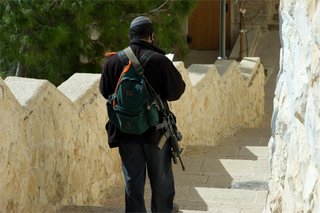
Another day of many stairs. My guesthouse is right near the Jaffa Gate (see picture). It just about the highest part of the old city. The tunnel Hezekiah had dug from the Gihon spring is at just about the lowest part.
So, today I went from my hotel and toured the City of David excavations all the way to the tunnel. Historic Jerusalem from top to bottom. Then I had to climb all the way back. More stairs than I ever want to see again. It was tough watching the tour groups get dropped of at the entrance and see their busses waiting to pick them up at the bottom.

Not as many people pictures today, but a few with some reflections. I am a proud father of girls, and as such I sometimes see the world through the eyes of a father. In Israel there are two main groups of people: Jews and Arab/Palestinians. Arabs who live in the Jewish state are often citizens, but tend to be treated as second class citizens. The two live very separate lives in most places.
All Jews serve in the military after they graduate from high school. Part of the training is to take them to historic location and to be sure they know their Jewish history. So you often find groups of young soldiers in training at some of the places you visit, in uniform and armed with M-16s.
This may sound a little sexist, but it’s still odd for me to see the groups of young women soldiers. Girls about 19, talking on cell phones and shouldering an assault rifle. I know in the USA we have many fine women soldiers, but we assume they are still somewhat unique and have some affinity for this kind of service. Here EVERY girl becomes a soldier. My daughter Alisha would be serving right now. I simply can’t imagine some of the cheerleaders I knew in high school trading in their pom poms for an M-16 right after graduation. Here are a few shots:


On the other side, few Arabs serve in the military. For them, it is not compulsory. Most of the kids go to schools that are segregated by sex and wear school uniforms (British influence). They look like kids everywhere. A few shots (note that the group of girls are playing with a Barbie sticker book and the one girl has a Barbie backpack):



It was strange to see these two groups side by side. Two peoples, sharing the same country, but having such different lives and futures. Maybe that's how people from outside the USA see the lives of whites and blacks when they visit us.

I can only imagine how their fathers worry about them. Thanks for looking.
PS to my family:
-Had a fabulous Middle Eastern dinner with Saliba tonight at a wonderful restaurant where everyone knew him (of course). I’ll have to take our group there when we go. He is doing great. Here’s a picture:






















































